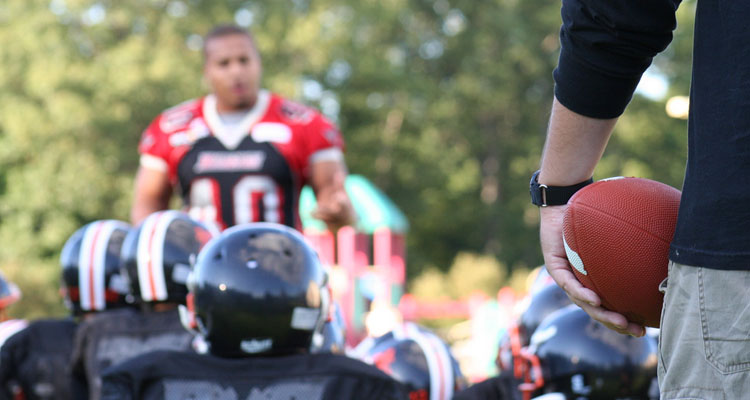Doug Gottlieb makes his living in sports. A former collegiate and professional basketball player, Gottlieb was a long-time ESPN analyst and talk show host, who currently has his own show on CBS Sports radio.
He’s also a parent facing a dilemma and a decision that thousands of others in America face: Should he ever permit his six-year-old son to encounter the risks associated with playing youth football? Gottlieb recently wrote extensively on that very question.
“My wife and I are kind of at a loss. I never have loved anything like I love my children. I played youth football and I am fine (some would dispute this). But kids are bigger, stronger, and the injuries seem to be getting worse despite the equipment and concussion protocol getting better. Of course I can tell my son ‘No.’ That is my job as a dad. But should I? Part of me wants him to get hit, know he doesn’t like it, and move on with other sports. But what if he does like it? Or maybe, what if this is what he is really good at? … Why take football away?”
Benefits of Youth Football
Football is currently the undeniable king of the American sports scene. Ingrained in our culture, it is big business, part of which extends into the world of education, with more than 850 football programs and 80,000 players at the college level. Football offers high school grads more full college scholarships than any other sport. And youth and high school team sports, including football, provide educational opportunities in physical education, cooperation, and leadership that cannot be denied.
Writing for the New York Times, researcher Kevin Kniffin, a teacher of leadership and management at Cornell University (an Ivy League school which does not offer athletic scholarships) found that “people who played high school sports tend to get better jobs, with better pay, and that those benefits last a lifetime. Hiring managers expect former student-athletes (compared with people who participated in other popular extra-curriculars) to have more self-confidence, self-respect, and leadership.”
But should parents allow those opportunities to extend to the gridiron?
Dangers of Youth Football
For many parents, Gottlieb’s ultimate question answers itself. There are inherent risks in any contact sport, but the nature of football can lead to an assortment of injuries affecting limbs, joints, and spine. In recent years, the emphasis has been on impact injuries to the head and the long-term effects associated with concussions. Research has shown that the cumulative effect of concussions can lead to serious medical complications, even death.
Caused by blows to the head, concussions are a type of traumatic brain injury that, unlike cuts and bruises, are invisible. According to the Sports Concussion Institute, less than ten percent of concussions involve a loss of consciousness. The institute has concluded that football is the most common sport with a concussion risk for males (it’s soccer for females), with 78 percent of sports concussions occurring during games, not practices. It estimates that a professional football player will receive 900 to 1,500 blows to the head during a season and that the impact speed of a player tackling a stationary player would be 25 mph.
Great strides toward eliminating concussions (thanks primarily to improved helmets) and in recognizing them have been made in recent years. Riddell, a leading manufacturer of football helmets, advertises its Insite Response System, utilizing in-helmet sensors and monitors for athletic trainers and coaches, on the American Youth Football and Cheer website. But costs restrict across-the-board application of new technologies for use in football and other impact sports.
USA Football, through its Heads Up training program, promotes proper tackling and blocking techniques, coaches’ certification, concussion recognition and response, and proper equipment to battle not only concussions but heat preparedness, dehydration and cardiac arrest issues. Rule changes have been implemented at all levels, from youth football to the National Football League (NFL), to eliminate helmet-to-helmet contact and promote proper techniques. In 2013, the NFL instituted new on-field and in-game protocol to deal with suspected concussions. But parents remain justifiably concerned.
Pop Warner, the nation’s largest youth football program, acknowledged a 9.5 percent decrease in participation between 2010 (248,899 players) and 2012 (225,287). Speaking to ESPN‘s Outside the Lines, Dr. Julian Bailes pointed to concerns about head injuries as the leading cause. “Unless we deal with these truths, we’re not going to get past the dropping popularity of the sport and people dropping out of the sport,” said Bailes, a former Pittsburgh Steelers neurosurgeon. “We need to get it right.”
The movie, Concussion, starring Will Smith, is set to be released on Christmas Day. Smith plays Dr. Bennet Omalu, a forensic pathologist who went toe-to-toe with the NFL and its attempts to suppress his research on brain damage. It was Omalu’s autopsy of former Pittsburgh Steelers center Mike Webster that led to the discovery of chronic traumatic encephalopathy (CTE).
[embedvideo id=”Io6hPdC41RM” website=”youtube”]
Last year, NYMag.com published a list of nine notable NFL players, past and present, who said they would discourage their child from playing football because of its inherent risks. That group included Brett Favre, Terry Bradshaw, Drew Brees, Troy Aikman, and Kurt Warner.
The story also included basketball superstar LeBron James, who prefers his kids play any sport other than football. “We don’t want (our kids) to play in our household right now until they understand how physical and how demanding the game is,” James told ESPN. “Then they can have their choice in high school. We’ll talk over it . . . But right now there’s no need for it. There’s enough sports they can play. They play basketball, they play soccer. . . . It’s a safety thing. As a parent, you protect your kids as much as possible.”
Do you or would you let your children play youth football? Would you encourage them to participate at the high school level or beyond? Share your thoughts with our readers.




































